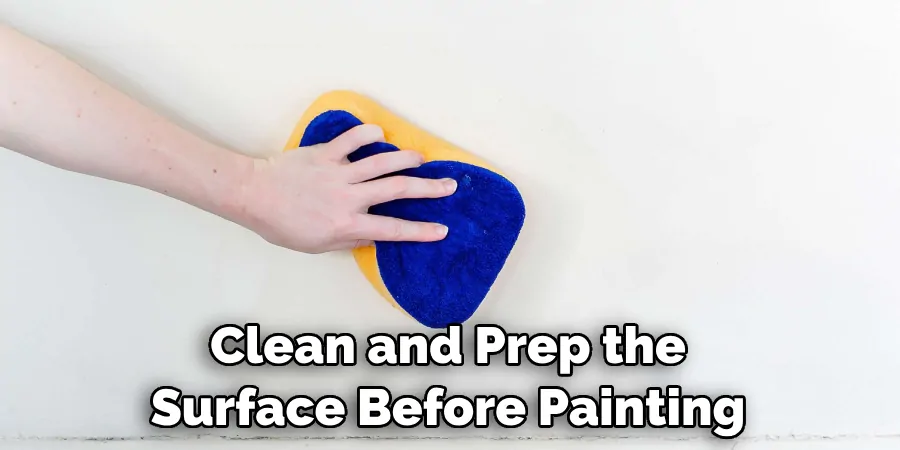Painting a light color over a dark one can be tricky. Not only do you have to ensure that the top paint is applied perfectly, but you also need to make sure that the base color looks smooth and even.

If done incorrectly, an amateur job will show through and ruin your hard work! Fortunately, there are some definite steps that you can take in order to successfully paint a light color over a dark. In this blog post, we’ll discuss how to paint a light color over a dark color!
Painting a light color on top of a dark color doesn’t have to be so tricky! Here we will discuss all the things you need to take into consideration when prepping and painting for this kind of job – from primers and sealers that will even out surfaces, to necessary tools both essential and extra that should help get the best results possible, as well as advice on choosing colors, paints and brushes that fit your intended outcome.
Why May You Want to Paint a Light Color Over a Dark Color?
1. To Draw Attention to a Particular Area
Painting a light color over a dark one can help draw the eye toward a specific part of the room or wall. This technique is often used in accent walls, where the lighter shade helps highlight certain areas.
2. To Update the Look of the Existing Space
Painting over darker colors with lighter ones can help bring new life to old walls and furniture. A fresh coat of paint can instantly transform the look of a room or piece, allowing you to make the space your own without having to do a complete overhaul.
3. To Create Contrast
Using light and dark colors together creates a contrast that can be visually appealing in any setting. The juxtaposition of light and dark colors can help create a dramatic look that stands out and adds interest to a room.
Now that you know why you may want to paint a light color over a dark one, let’s discuss the steps you need to take in order to do it correctly. The process is fairly simple but requires some attention to detail for best results.
How to Paint a Light Color Over a Dark Color in 5 Easy Steps
Step 1: Gather All The Tools You Need
The very first step is to make sure you have all the necessary tools and supplies for your painting project. You will need a paintbrush, painter’s tape, high-quality interior or exterior paint in light and dark colors, a drop cloth, as well as any other materials your painting project may require.

Step 2: Prep The Surface
Before you start painting, it is important to make sure the surface you are painting on is clean and properly prepared. Wipe down the walls or other surfaces with a damp cloth to remove any dust or grime. You may also need to sand down rough areas or fill in any holes or cracks before proceeding.
Step 3: Tape Off The Area
After prepping the surface, you will want to use painter’s tape to protect any areas that do not need to be painted. This is especially important when painting a light color over a dark one as you don’t want the darker color to show through.
Step 4: Apply The First Coat
Once the area is prepped and taped off, it is time to apply the first coat of paint. Start with the darker color and allow it to dry completely before applying a second coat.
Step 5: Apply The Light Color
Finally, it is time to apply the light color over the dark one. Again, be sure to let each layer of paint dry completely before applying another. Once the final coat of paint is dry, you can remove the painter’s tape and admire your work!
With these five easy steps, you can successfully paint a light color over a dark one. Remember to take all necessary safety precautions when working with paints and other materials and always allow ample drying time between coats for best results.
Some Tips o Paint a Light Color Over a Dark Color
1. Choose Latex Paint for Your Top Coat
One of the most important tips when painting a light color over a dark color is to use latex paint as your top coat. Oil-based paints are not recommended for this project because they may become transparent and allow the dark color to still show through the new coat of paint.

2. Prepare Your Walls
Before you start painting, make sure that all of the walls are heavily primed and clean. You may need to sand the walls down if they have any glossy paint on them. Once your walls are fully prepared, you can start painting your light color over the dark color.
3. Use Multiple Coats
Using multiple coats of latex paint will help to ensure that all of the dark color is covered. Make sure that you let each coat of paint dry completely before adding a new one. A minimum of two coats should be applied, but more may be necessary depending on the darkness of the original wall color.
4. Add a Primer
Adding a good primer to your walls can help with lighter colors that are prone to fading or discoloring. The primer will help to form a better bond between the wall and the light paint, making it less likely that the dark color will show through.
5. Consider an Accent Wall
If you’re still having trouble covering up all of the dark color, consider using an accent wall to add some contrast to your space. You can choose a darker color for the accent wall and then paint the other walls with your light color. This will help to create a more visually interesting space.

These tips should help you to successfully paint a light color over a dark color. With some patience and preparation, you’ll have beautiful walls in no time! Good luck!
Frequently Asked Questions ?
What Precautions Should I Take When Painting a Light Color Over a Dark Color?
To ensure the best results, make sure to apply a quality primer before painting the light color. Primers are designed to block tannin bleed and other stains from seeping through the paint layer. Also, be sure to use quality paints that cover well and have good adhesion.
How Long Should I Wait Before Painting the Light Color?
You should wait until the primer is completely dry before applying a light color over a dark color. Depending on the climate, this could take anywhere from one hour to 24 hours. Make sure the primer has had enough time to dry and set so that it can provide an effective base for the light color.
Do I Need to Sand Before Painting a Light Color Over a Dark Color?
It’s usually not necessary to sand before painting a light color over a dark color. However, if you are using oil-based paint, then it’s important to lightly sand any glossy surfaces so that the primer and light color can adhere properly.
Do I Need to Use a Different Brush When Painting a Light Color Over a Dark Color?
Yes, you should use an angled brush when painting over dark colors. This will help ensure that the paint is applied evenly and smoothly so it covers the dark color without any visible lines or uneven patches.
What Should I Do If I Notice Streaks or Fading After Painting a Light Color Over a Dark Color?
If you notice fading or streaks, it’s important to take action right away. You may need to apply additional coats of paint, and make sure not to leave any gaps between the brush strokes. You can also add an extra coat of primer to ensure even coverage of the light color.
What Are Some Tips for Making Sure My Light Color Lasts?
To make sure your light color lasts, it’s important to apply a quality primer and use good quality paints. You should also be sure to clean and prep the surface before painting. Make sure you use an angled brush when painting, and take your time to make sure the paint is applied evenly. Finally, consider adding a sealant after the paint has dried to preserve its color and durability.

Can I Paint a Light Color Over a Dark Color Without Primer?
No, it’s not recommended to paint a light color over a dark color without primer. Primers block stains and tannin bleed from seeping through the paint layer, so they are important for creating an even finish. In addition, primers provide good adhesion between the wall and the paint, so they help ensure that your light color will last.
Conclusion
Now you know how to paint a light color over a dark color! Painting light color over a dark color can be a tricky process, but it is possible and rewarding when done correctly. Start by prepping the wall and applying multiple coats of primer. If that doesn’t do the trick, tinting the primer is an excellent option. For painting, use high-quality paint in order to avoid any unsightly streaks or patches.
Always take measurements and mark them on your wall or ceiling so you can accurately calculate how much paint you will need for each area. Lastly, remember no matter which materials you choose, always apply several thin coats to ensure an even finish. With patience and careful planning, painting a light color over a darker one can be a great transformation.

